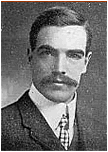
The Editor, Fernie Free Press
Fernie, BC [Spring 1919]
Dear Sir: - My recent trip of well over 12,000 miles through the states of Idaho, Washington, Oregon and California as far south as Mexico, and my previous trip of 23,000 miles in which I covered the whole of Saskatchewan, Alberta, and British Columbia, have convinced me more firmly than ever of the correctness of my oft made assertion that in this district and within a radius of 50 miles from Fernie, we have absolutely the finest scenery there is in the whole of the North American continent.
Excerpt from Letter signed ďFred SpaldingĒ
In the above letter, Spalding writes about a recent automobile road trip covering over 12,000 miles through Idaho, Washington, Oregon and California as far south as Mexico. Considering his previous trip in the fall of 1913 over some 23,000 miles of roadways though Saskatchewan, Alberta, and British Columbia, it would be an understatement to say that Spalding was passionate about automobiles and road travel.
In addition to recording personal impressions of his 1913 journey, Spalding diligently logged the miles with a speedometer, made detailed notes about garages and hotels, and highlighted places of interest and outdoor opportunities that might be found along the way. He published the first guidebook of his travels in 1918, titled Official Automobile Road Guide for British Columbia, Alberta and Saskatchewan. An excerpt documenting a portion of the journey from Hope to Lytton follows:
Owing to our failure in getting over Jonesís Bluff, we had to turn back to Rosedale from where we intended to take the ferry across to Agassiz, and from there ship the car by the CPR to Lytton. On the way back, we had two blow outs to our intense disgust, which made the third that day. The ferryman would not take us across that night as the river was low and the landing on the other side a poor one, so we had to stay the night. The only place was a kind of temperance hotel and fairly comfortable.
The success of the first automobile guide led to Spaldingís second journey noted above and the publication of another road guide, this time documenting 12,000 miles of raod through the western United States to Mexico.
Even today, with fast, comfortable automobiles and well-maintained highways, a road trip of 23,000 miles, in winter conditions, is verging on extreme. An accounting by Spalding of his travels between BC and Saskatchewan in the Preface to his first publication offers insight into the arbitrariness of the project. Even though the automobile guide was a success, the entire undertaking was clearly a labour of love:
The actual time spent on the road was 346 days, average daily expenses at hotels, mechanics wages, $12 garage bills for repairs, storage, gasoline and oil $900.00 and two completer sets of tires, to which has to be added the cost of printing and binding, and other incidental expenses. The sale of a book of this kind is a limited one, consequently the returns are slow, so a careful consideration of the above facts by the reader will convince him that the price of this book ($3.00) is exceedingly moderate.
Spending almost an entire year on the road is bound to make a driver a little bit cranky and Spalding gently admonishes drivers in a document headed, A Page of Doníts for the Autoist in B.C. Several of Spaldingís rules for the road truly represent a journey back through time:
- DONíT show off your carís capabilities for speed through towns. Eight miles an hour is the limit in some, 10 miles in most.
- DONíT curse a teamster whose horses are restive and delay you. Autos are yet strange in parts of B.C., besides you might be glad enough of a teamsterís help some time or other.
- DONíT go into B.C, under the impression that it is the wild and woolly West, that you can cutíer loose and everything goes. There is a higher plane of civilization here than in most places, and a very effective body of police who generally speaking, wont stand for the rough stuff.
- DONíT take any chances with a poor machine in this Province. Repair shops are few, and while the majority of blacksmiths can fix up minor breaks unless you are near one of the larger towns or carry extra parts with you, you are very liable to get hung up. Even the best cars will get a very thorough testing here.














